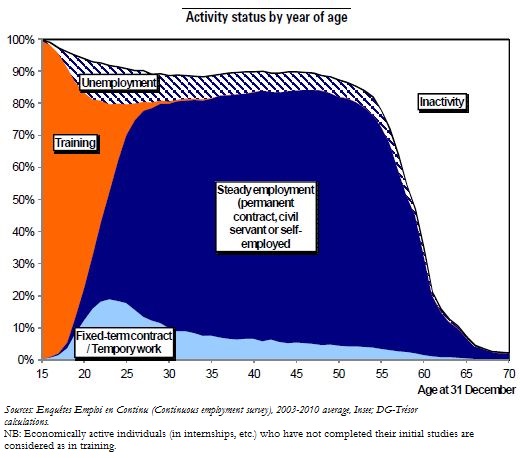Trésor-Economics No. 92 - Diagnosing youth unemployment
The recent crisis has again drawn attention to the difficulties young people face in finding work. Unemployment for the 15-24 age group was 22.8% in first quarter of 2011 (versus 8.4% for 25-49 year-olds).
This non-prescriptive study seeks to identify the difficulties young people face when entering the labour market by analysing available indicators and school-to-work pathways.
The unemployment rate by age group poorly reflects the specific difficulties young people face in finding work. Earlier entry into the labour market by the least-qualified young people, and above all the over-representation of workers recently arrived on the labour market, leads to higher youth unemployment, via a structure effect. Conversely, students in work, who are therefore considered to be economically active, mechanically lower the unemployment rate for their age group.
A survey of transitions into work highlights the fact that young people experience no greater difficulty in finding work than people of median age also entering the labour market or who have become unemployed. The high rate of youth unemployment and the difficulties they encounter in finding work primarily reflect the two-tier nature of the labour market and its lack of fluidity: finding stable work is hard for people entering the labour market, whatever their age. In international comparisons, the youth unemployment rate relative to the rest of the working population in France is in line with most other European countries.
However, young people encounter a number of specific factors in their search for work. While they find work relatively quickly by comparison with older people, they hold onto their jobs for shorter periods. Consequently, for many of them, spells of unemployment inevitably alternate with short-term contracts (see chart below). These episodes have lasting, albeit ambiguous, effects on their entry into the labour market: accepting a temporary first contract rather than staying unemployed raises a person's chances of finding steady work in the long term; conversely, a succession of short-term contracts may make it harder to find steady work.
Some young people also encounter particular difficulties, as in the case of "drop outs" who left the school system early, or certain graduates lacking the right qualifications for work; this latter situation is more common in France than among its neighbours.
Finally, the price for finding work is often a form of "demotion", i.e. taking jobs less qualified than those for which new labour market entrants are trained. In the short run, this crowds out the less qualified and leads to inefficient use of the labour factor. This is prejudicial to steady employment in the longer run.
This study of school-to-work pathways could be complemented by an analysis of factors shaping demand for labour.
